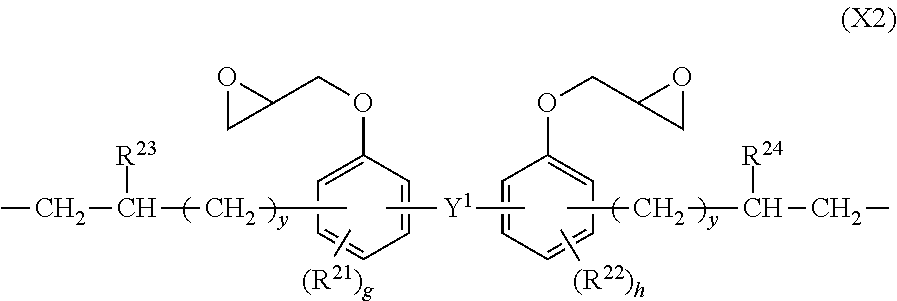Photosensitive resin composition and pattern forming process
a technology of which is applied in the field of photosensitive resin composition and pattern forming process, can solve the problems of poor resolution, peeling or cracking of cured coatings from substrates or cracks, and less resistance to chemicals such as photoresist strippers, and achieves light resistance, easy to form films, and effective micro-processing
- Summary
- Abstract
- Description
- Claims
- Application Information
AI Technical Summary
Benefits of technology
Problems solved by technology
Method used
Image
Examples
synthesis example 1
[0151]Synthesis of Resin A-1
[0152]A 3-L flask equipped with a stirrer, thermometer, nitrogen purge line and reflux condenser was charged with 265.0 g (1.00 mol) of Compound (S-5), then with 2,000 g of toluene and heated at 70° C. Thereafter, 1.0 g of a toluene solution of chloroplatinic acid (platinum concentration 0.5 wt %) was added, and 164.9 g (0.85 mol) of Compound (S-1) and 453.0 g (0.15 mol) of Compound (S-2) (y1=40) were added dropwise over 1 hour. The ratio of the total moles of hydrosilyl groups to the total moles of alkenyl groups was 1 / 1. At the end of dropwise addition, the reaction solution was heated at 100° C. and aged for 6 hours. Toluene was distilled off in vacuum from the reaction solution, yielding Resin A-1. On analysis by 1H-NMR and 29Si-NMR spectroscopy (Bruker Corp.) and GPC, the structure of Resin A-1 was identified. Resin A-1 had a Mw of 65,000 and a silicone content of 51.3 wt %.
synthesis example 2
[0153]Synthesis of Resin A-2
[0154]A 3-L flask equipped with a stirrer, thermometer, nitrogen purge line and reflux condenser was charged with 111.6 g (0.60 mol) of Compound (S-3) and 156.8 g (0.40 mol) of Compound (S-4), then with 2,000 g of toluene and heated at 70° C. Thereafter, 1.0 g of a toluene solution of chloroplatinic acid (platinum concentration 0.5 wt %) was added, and 135.8 g (0.70 mol) of Compound (S-1) and 906.0 g (0.30 mol) of Compound (S-2) (y1=40) were added dropwise over 1 hour. The ratio of the total moles of hydrosilyl groups to the total moles of alkenyl groups was 1 / 1. At the end of dropwise addition, the reaction solution was heated at 100° C. and aged for 6 hours. Toluene was distilled off in vacuum from the reaction solution, yielding Resin A-2. On analysis by 1H-NMR and 29Si-NMR spectroscopy (Bruker Corp.) and GPC, the structure of Resin A-2 was identified. Resin A-2 had a Mw of 55,000 and a silicone content of 77.7 wt %.
synthesis example 3
[0155]Synthesis of Resin A-3
[0156]A 3-L flask equipped with a stirrer, thermometer, nitrogen purge line and reflux condenser was charged with 111.6 g (0.60 mol) of Compound (S-3) and 106.0 g (0.40 mol) of Compound (S-5), then with 2,000 g of toluene and heated at 70° C. Thereafter, 1.0 g of a toluene solution of chloroplatinic acid (platinum concentration 0.5 wt %) was added, and 174.6 g (0.90 mol) of Compound (S-1) and 302.0 g (0.10 mol) of Compound (S-2) (y1=40) were added dropwise over 1 hour. The ratio of the total moles of hydrosilyl groups to the total moles of alkenyl groups was 1 / 1. At the end of dropwise addition, the reaction to solution was heated at 100° C. and aged for 6 hours. Toluene was distilled off in vacuum from the reaction solution, yielding Resin A-3. On analysis by 1H-NMR and 29Si-NMR spectroscopy (Bruker Corp.) and GPC, the structure of Resin A-3 was identified. Resin A-3 had a Mw of 50,000 and a silicone content of 59.6 wt %.
PUM
| Property | Measurement | Unit |
|---|---|---|
| particle size | aaaaa | aaaaa |
| wavelength | aaaaa | aaaaa |
| particle size | aaaaa | aaaaa |
Abstract
Description
Claims
Application Information
 Login to View More
Login to View More - R&D
- Intellectual Property
- Life Sciences
- Materials
- Tech Scout
- Unparalleled Data Quality
- Higher Quality Content
- 60% Fewer Hallucinations
Browse by: Latest US Patents, China's latest patents, Technical Efficacy Thesaurus, Application Domain, Technology Topic, Popular Technical Reports.
© 2025 PatSnap. All rights reserved.Legal|Privacy policy|Modern Slavery Act Transparency Statement|Sitemap|About US| Contact US: help@patsnap.com



